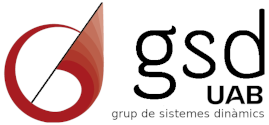Events Calendar
- In this talk, we will study the Josephson equation $\beta \frac{d^{2}\Phi}{dt^{2}}+(1+\gamma \cos \Phi)\frac{d\Phi}{dt}+\sin \Phi=\alpha$, which can be transformed to the following Liénard systems on the cylinder: $$\frac{dx}{d \tau}=y, \frac{dy}{d \tau}=-(\sin x-a)-(b+c \cos x)y.$$ We are concerned with the non-contractible limit cycles, which are the isolated $2\pi$-periodic solutions $y=y(x)$.
We show that these limit cycles cannot intersect the $x$-axis. Then by the transformation $y \rightarrow \frac{1}{y}$, the system becomes an Abel equation $$\frac{dy}{dx}=(b+\cos x)y^2+(\sin x-a) y^3.$$
The problem is changed to study the non-zero limit cycles of the above Abel equation. By the theory of rotated vector fields and studying the multiplicity of limit cycles, we will show that at most two non-zero limit cycles can appear and that the configurations $(2, 0)$ and $(1, 1)$ can be realized. Here we denote the configuration of the limit cycles by $(i, j)$, if $i$ limit cycles belong to the half plane $y>0$ and $j$ limit cycles belong to the half plane $y<0$.
This is a joint work with Xiangqin Yu and Hebai Chen and our work can be viewed as a step to solve the following open problem raised by A. Gasull:
Open problem: $\frac{dx}{dt}=(a_0+a_1\sin t+a_2\cos t)x^3+(b_0+b_1\sin t+b_2\cos t)x^2$ have at most three limit cycles (The trivial limit cycle $y=0$ is included).
